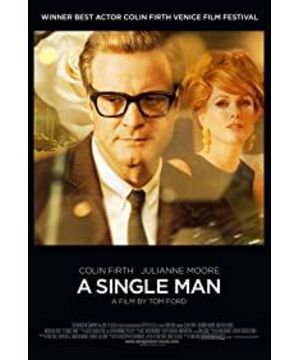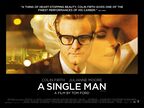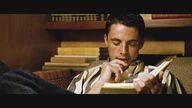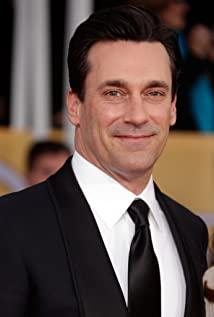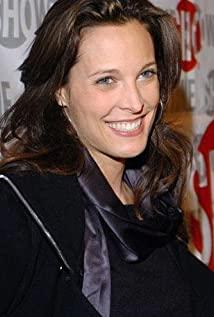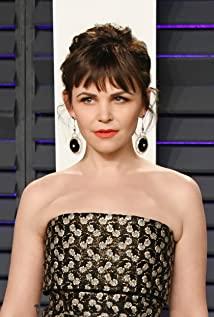2020 starts, closed for a week. A neighbor said that every morning when he wakes up to look at his phone, his mind is full of Colin's sentence "Just get through the goddamn day" (Or, maybe the goddamn year) in "A Single Man" looking in the mirror. This got me thinking about rewatching it. Although it may not sound desirable to repeatedly soak in a depressing film on such a low-pressure day, out of the storyline and free from the creator's emotional manipulation, archaeological viewing can keep the mind clear and calm. Calm, the taste will be much better.
"Single Man" was Tom Ford's first self-funded film ten years ago. The story is adapted from the 1964 novel of the same name by American novelist Christopher Isherwood. It tells the story of a middle-aged college professor who is immersed in the shadow of widowhood and unable to extricate himself. Although the storyline itself is almost a low-level version of "The Hours", the finished film bluntly displayed Tang's aesthetics, hobbies, tastes, cleanliness and all orientations, and won the best art direction of Critics Choice and BAFTA's best art direction in one fell swoop. Best Costume Design Award nominee. It also attracted a lot of critics who didn't buy it, and criticized the film as "indulging in extravagance and suffocation and shooting in a bad direction, and the director's extreme fetishes also turned the characters into kitsch and cliché." Turning to an old interview, Tom admitted that he was the most influenced by Wong Kar Wai after winning the award in Venice. It occurred to me that for such directors, it would be much easier and more fun to probe into their hidden and great fetishes on the screen than to stick to their narratives.
Mad Men
It's risky for Tom to borrow these elements from famous directors, and while they do work sometimes, they're not what makes the film charming.
If you pay attention to the cast list at the end of the film, it is not difficult to find that Tang Fu, who is a creative director, knows very well how to form a team that suits his own taste. He brought in production designer Dan Bishop, set designer Amy Wells, art director Ian Phillips, and photographer Eduard Grau of the Mad Men design team to serve as the core members of the entire creative team, working together to study the film's scenes, props and art design, for the story and Characters add dimension. Mad Men was originally the abbreviation of an advertising agency called "Madison Avenue" Men in New York, whose design style borrowed elements from popular culture in the 1960s. According to reports, in order to create the atmosphere of urban life in California in the 1960s, the creative team referenced many covers including "Life" magazine, the work of famous fashion photographer Bob Richardson (Bob Richardson), and "American Beauty", Film design styles of the same period as "The Graduate" and "Chinatown". Even rigorous enough to write a story behind every prop or costume used on the set. As Tom Fu himself said, "This does not mean that this film is only a partial film."
George and Charley's Houses
"Single Man" is set in Santa Monica in 1962, and the interior scenes mainly include the home of George, played by Colin Firth, and the home of George's old London lover, Charley, played by Julian Moore. For Tang Fu, a director who has high demands on the home environment, finding suitable homes for the protagonists is the first priority of creation.
According to the script setting, Jim, who lives with George, is an architect, and the dialogue between the two outside the glass house at the beginning is very interesting - "I don't think you are quite ready for a life in a glass house" "You are the one who is always saying we're invisible." And the wood-framed glass house in the movie was actually built by American architect John Lautner in 1949 for the mother of one of his employees Designed and built. The mahogany-designed open-plan living Schaffer House is tucked away in a valley of rubber groves beneath Glendale Mountain. The timber-framed glass house blends naturally with the surrounding hills. Although not quite as glamorous as Lautner's later works, the design of this tiny two-bedroom house clearly differs from the ardent modernism of his later years.
In stark contrast to George is Charley's luxurious and high-profile home furnishing and living. Charley's home is located in a luxury landscaped residential complex in Pasadena. The interior is decorated in feminine creams and pinks and mid-century Hollywood Regency with strong Moroccan accents. Charley's bedroom, in particular, has two oversized ivory shade lamps on the lavish vanity, and in the center is a North African-inspired vanity mirror inlaid with bone and wood glitz, and the mirror hangs in a white lacquer in typical Hollywood Regency style. Ornately carved wooden screen. Coral-white botanical tablecloths are paired with tie-dyed fabric curtains, while pink rugs and chairs are upholstered in white plush. It is said that even the green plants in the living room were moved by Tang Fu from home.
Dress well
La Dolce Vita (La Dolce Vita) directed by Federico Fellini in 1960 showed the world sophisticated Italian fashion through the image of an unscrupulous celebrity photographer, proving by the way that the gulf between fashion and film is not so insurmountable. The fashion tycoon Tang Fu started filming his debut film in the 1960s, and naturally he has to show his skills in clothing design. Surprisingly, Tom himself did not do the costume design for the film, but instead invited Madonna's personal stylist and Walk in Line designer Arianne Phillips to work in Italy. room for co-creation.
To fit George and even Colin himself, the creative team bought a large number of white shirts from Turnbull & Asser and folded them neatly in a bedroom closet drawer for a suit jacket with '60s burlap, boxy cuts and rounded shoulder pads . Arianne said in an interview that "George's world has an extremely precise and rigorous quality. Trying to control his life after losing a lover but chewing out of control over and over again. On the other hand, as an Englishman, the way he dresses has Representational, an emotional armor. So the way he wears it is his way of life." And Tom even put George's name and the year of manufacture on the inside of the suit, and designed the suit's source. Backstory: This is an old suit worn for a few years, tailored by George on Saville Row during a trip to England. As for accessories, Tom still insisted on abandoning his own brand, and chose for George a pair of retro black-rimmed glasses popular in the mid-20th century from Nalco and the Bois du Portugal produced by Creed in 1957, an oriental fragrance for men. With perfume, base notes are cedar, sandalwood, vetiver and ambergris.
In addition to George's shirt, Charley's black and white patchwork cocktail dress was another highlight. Arianne and Tom discussed that in the drunken dance scene, the change of clothing is limited, so the design must be precise. They decided to go with a black and white colorblock dress with a Watteau back drag hem and decorative metal drop earrings. Charley dancing in it has a touch of grace and uninhibitedness that reflects the indulgence and chaos of her life.
Pretty Young Thing
In addition to clothing, the creative team also put a lot of effort into restoring the home life of the 1960s in the United States. The round metal case ivory alarm clock at the head of George's bed is the Hustler Alarm Clock series produced by Westclox Company around 1958. Westclox, a long-established clock manufacturing company, introduced and patented a stylish "Sleepiness" alarm clock in 1959, the first of its kind to be powered by electricity and with a "snooze" function. Alarm clock.
Stationery lovers will probably notice George's pens, well-organized desk and stack of Smythson writing paper with "GEORGE FALCONER" letterhead. The male protagonist used it to write his last words, including the simple "Tie in a Windsor" (please tie the Windsor knot). The 7" by 5.5" letterhead with woven white weave was printed by the legendary Bond Street Smithsonian (Steve Smythson). Currently, the writing paper is only available at Smithsonian locations in Beverly Hills and New York.
Charley's "equipment" is the most eye-catching pink cigarette with a gold foil tip. Although there is no evidence that the pink cigarettes featured in the film are the sobranie cocktails that were born in the 19th century and then swept the high society in Europe, the cigarettes with gold foil tips were indeed very popular in London in the 1960s. In addition, the director also arranged another love for Charley - Tanqueray gin from London, Charley asked George to bring a bottle for the evening, and declared "I like the color of the bottle".
Virgo director Tom even spared the medical emergency supplies of George's family.
Professor Falconer's Books
In the film where George and Jim are sitting opposite each other on the sofa and reading with books in their hands, Kafka's "The Metamorphosis", which George, a university professor of literature, was preparing for his teaching was mocked by Jim as "depressing crap". ) and the copy of Truman Capote's "Breakfast at Tiffany's" in Jim's hand was the original, first published by Signet in November 1959. Tom Fu's strictness to the first edition of the book is also reflected in another important prop of the film. Huxley's "After Many a Summer", which George sat on the toilet to read early in the morning and brought to class for discussion, was the first edition released in 1939, according to the autographed version auctioned by an auction site.
On the other hand, it might not be accurate enough to say that Tom is just a strict and obsessive fetish director. Tang Fu's choice of "After Many a Summer" as an important prop throughout the last day of George's life has his own set of logic. According to research, the title of "After Many a Summer" comes from the poem "And after many a summer dies the swan" by the British poet Alfred Lord Tennyson, which is consistent with the aesthetic tone of death of the film. And the theme of this novel happens to tell the story of a rich man who is afraid of death and asks people to accompany him to think about life in order to seek eternal life. Coincidentally, the novel was written shortly after Huxley himself left England and settled in California, expressing the author's scrutiny of American culture, especially his dissatisfaction with American culture's narcissism, superficiality, and obsession with youth. This is very similar to George's migratory life background and cultural psychology in the film. If not a coincidence, the fashion designer's precise intuition, keen insight and understanding of literary expression are as amazing as his talent for visual aesthetics.
Don Bachardy's Painting
Another interesting design, although there is no clear picture in the movie to provide support, according to the information on the IMDb homepage, there is a portrait of the portrait artist Don Bachardy in George's home in the movie. And Bachardy himself is the partner of Christopher Isherwood, the original author of the film. It is said that they first met on the beach in the Santa Monica Canyon in Los Angeles, and Bachardy was 18 years old, with a silly toothy grin that made him look younger than Isherwood, who was 48 at the time. By then, Isherwood had published several books, was a well-known author, and later taught a course in modern English literature at a university in Los Angeles. This kind of plot is really like George and Jim in the movie.
According to reports, Tang Fu came to lobby after seeing the original novel of "Single Man". Bachardy, who owns the rights to all of Isherwood's writings, gave Tom Fu the green light, even though the latter had absolutely no filmmaking experience. Talking about Tom's invitation, Bachardy recalled, "When I first met, I realized that if anyone could make Chris's book into a movie, it would be him."
Ten years later, even Colin himself lamented in a 2016 interview that the director was "passionate and infectious, and makes you want to travel, read or gallery, or at least Google." As Tom Fu himself said: " Films gave me a lot of design inspiration in the early years, such as Petra von Kant in 1972. But I gradually realized that making a film, like making a design, is about creating a vision. It’s not about making a film. More advanced, making a film is essentially the same as trying to get a heel in a delicate shape from a shoe factory — I have to know what I love and want and get it.”
The original text was first published on the public account: Roslie's private plot
Written & Editor: Roslie Liu
View more about A Single Man reviews


